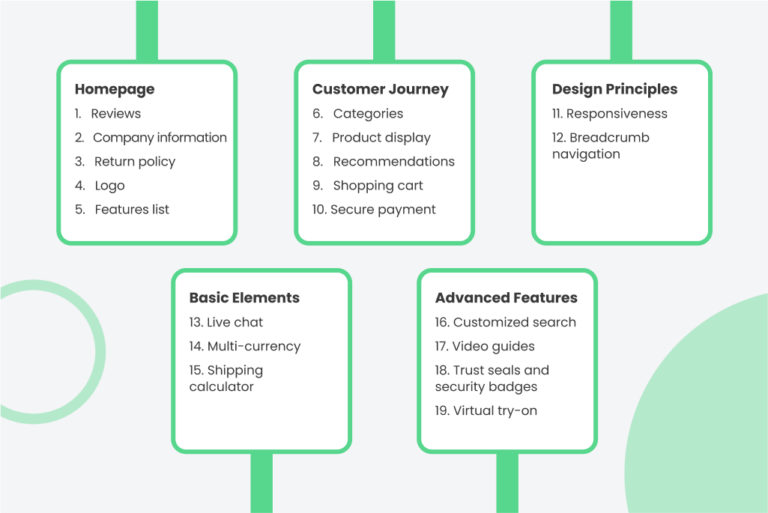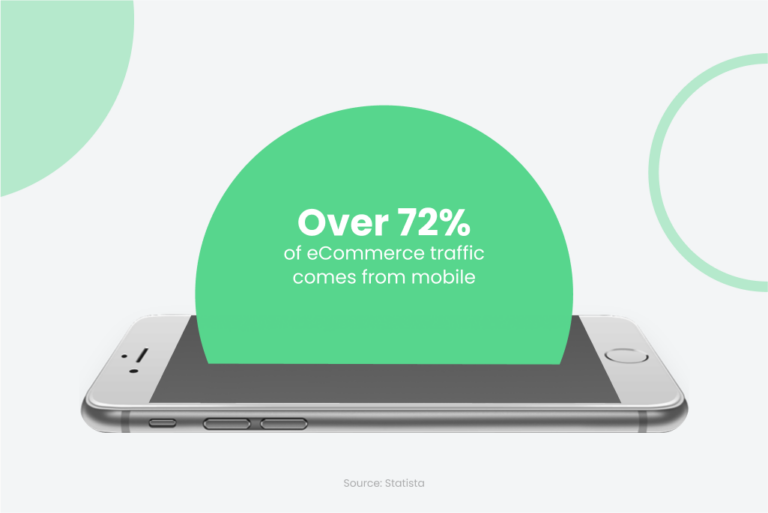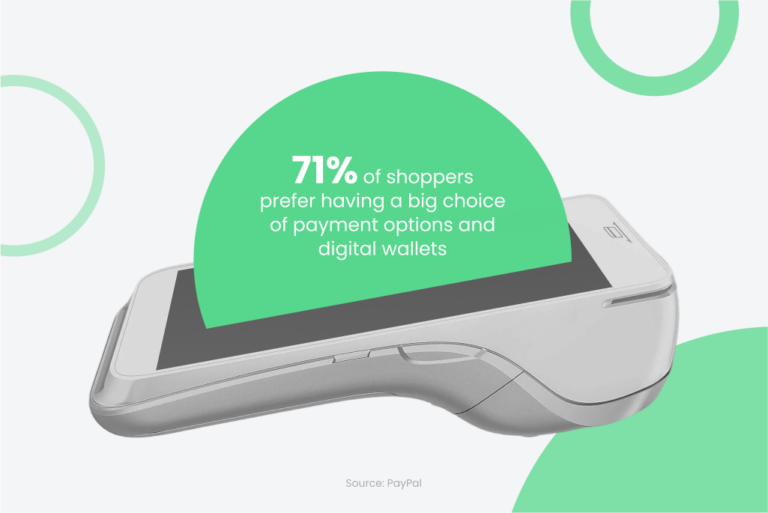Good eCommerce websites are designed with the customer experience in mind. They provide ease of use, findability, and convenience to encourage purchasing behavior and boost conversions. For example, you don’t want to have a website that can only accept credit cards from one payment processor when you could be accepting payment from several different companies.
There are many different aspects to consider when designing a good eCommerce website, from how it performs in various browsers to the site’s load speed and search engine optimization (SEO). But having the right features is vital, too. This article explores 19 must-have eCommerce features in website design for online stores of all types, sizes, and budgets.
Elements of eCommerce Homepage Design
#1 Customer Reviews (Real Ones!)
If you’re selling a product, think of customer reviews as a crucial element of eCommerce homepage design and of your product pages. They help potential customers feel more confident about buying your products and services — especially since most online shoppers rely on other people’s opinions before making a purchase.
Think about it: if you read online reviews for hotels and vacation rentals before deciding where to stay on your next trip, why wouldn’t you do the same when shopping for something as important as a new air conditioning unit? In any case, feedback and testimonials are great ways to show that other people have used your products or services and found them valuable.
It’s critical to get real customer reviews: shoppers trust third-party review solutions more than any native website widgets. The reason for such a trust is that platforms like Trustpilot have special rules for detecting fake reviews.
To get genuine customer reviews as must-have features of eCommerce website, create a clear path for customers to leave reviews and reward those doing so. For this, try offering a discount on the next purchase with a follow-up email after order placement, for example.
Want to see examples of best-selling eCommerce website design? Check out our guide: Magento website design.
#2 Company Information (Which Is Not a Feature of eCommerce but Very Important)
Users expect to see contacts and company representation on the main page because they give users a sense of who they are doing business with and what their values are. As such, it is important that you have a well-designed “About Us” page that highlights all these things.
If you want to design “About Us” for eCommerce website properly, the first thing is to give your clients an understanding of how you operate and what makes you different from others. Make sure it’s clear how your process works and how to contact you for questions.
Also, make your contact information visible on the home page. For this, place in this section your phone number, email, and physical address. By the way, having this information on the website increases your authority for Google bots, especially if it’s easy to find.
#3 Guarantees and Return Policy Section
Return policies are important, especially for a business that sells products online. They let customers know you stand behind your products and allow them to shop more confidently on your site.
Customers want to feel confident with their purchase and that they won’t be ripped off if they don’t like something or it doesn’t fit. Thus, having a solid return policy is among the must-have eCommerce features. Also, you should mention whether or not you have free shipping and how long it takes for your items to ship out from when an order is placed.
#4 Logo
A logo serves as a company’s identity and plays an important role in conveying information about your brand. It’s one of those features of an eCommerce website that people will see and remember, so take your time and choose something memorable and unique that works with your branding efforts.
In terms of online store design, a logo should be an image that delivers relevant visual information about your company. Is it modern? Trusted? High quality? When creating a logo, be sure to keep these qualities in mind so you can convey them to potential buyers.
#5 eCommerce Website Features List
Homepage is the first place your users see, so use this page to represent all the options you have to offer. When designing an eCommerce website features list, make sure that your site’s content is organized in a way that makes it easy for customers to find what they are looking for.
This can be done by using product categories and tags or by offering a search bar on every page. In this regard, the eCommerce homepage design should show a clear path to start the customer journey to purchase a product.
eCommerce Features for Better User Flow
#6 Categories
As an important type of features of eCommerce website design, categories allow users to look for information that is relevant. Simply put, they make eCommerce website search easier, helping visitors narrow down their search if they are looking for something specific.
For convenience, this section is not intended to be an exhaustive list, but rather a few categories that will help you break down your eCommerce website search. When deciding what categories to add, think about your target market and what types of products or services you offer, like Women’s Shoes or Dresses for Maternity. Leave only the most relevant information and hide all the remaining details in subcategories.
#7 Product Display
The best online store design should offer an attractive and easily accessible way to display products. This aim can be achieved with different tools and solutions.
Using a grid or carousel layout is one good way to present your products, with some sort of eCommerce website search functionality to make it easy for people to find exactly what they are looking for.
#8 Recommendations
In-built recommendations of different kinds are the vital features of eCommerce websites. It is essential to have a recommendation engine in place that will show products to users based on their previous purchase history, browsing history, and other factors like location and demographics. It is important to offer a personalized shopping experience for every customer and make them feel special about your brand.
A great way to add these features of an eCommerce website is by recommending products that you think they might be interested in based on their past behavior on your website (try third-party solutions like Nosto for that).
Check out more ways to increase eCommerce conversion rates and boost sales.
#9 Shopping Cart Area
In the eCommerce features list, a store’s shopping cart is the place where your customers will purchase your products. It is important to keep it clear and clutter-free for ease of use. For this, a strong call-to-action button that clearly indicates Add to Cart or Checkout Now should be present on every page in a prominent position.
The placement of your product images is also crucial as they are what entice people into buying from you. If possible, always put these eCommerce features above the fold so that they can be seen without having to scroll down first. This will help with conversion rates as more people see them and click on them before leaving your site.
#10 Secure Payment Methods
Safety and privacy are the basics for websites these days. If you don’t want customers to worry about security or their personal information being stolen, add secure payment methods like PayPal or SSL encryption into your list of must-have site features.
Also, this feature looks more reliable with a solid privacy policy. Together, these eCommerce website features inform customers how you use their information and build trust with potential buyers.
Online Store Design Principles
#11 Responsive Design
According to Statista, over 72% of retail eCommerce comes from mobile devices. As smartphones and tablets have become more common, consumers have begun to expect that your website is mobile-friendly, too. That’s why responsive design has become so common.
In essence, this web design approach is aimed at crafting sites to provide an optimal viewing experience — easy reading and navigation with minimal resizing, panning, and scrolling — across a wide range of devices (from desktop computer monitors to mobile phones). For example, it lets your homepage load quickly on both — your smartphone and computer monitor.
Responsive design is a common practice today, so when building a website, make sure you follow this principle. You can also strive for better solutions as progressive web applications that will not only improve your overall CX following the principles of responsive design and app-like experience, but also speed up your website and give an opportunity for your visitors to install your website as an app.
#12 Breadcrumb Navigation
Smart use of breadcrumbs is necessary for search engine visibility of your online store design. As key features of eCommerce website, breadcrumbs allow visitors to navigate easily through your site, and keep them from abandoning their carts and bouncing off your site.
Having a hierarchical navigation system that mirrors Google’s can help encourage people to click through to higher levels in your navigation (read: products) and increase sales conversions. For example, instead of Home > Clothing > Men’s Clothing > Shirts and Jackets, it might be better to have Home > Men’s Clothing > Shirts & Jackets or something similar — and offer links down deeper into categories on each page as well.
This makes it easier for visitors to find what they’re looking for and increases your chances of making a sale.
Read more about online store design principles: the basics of the PWA design.
Basic eCommerce Website Features
#13 Live Chat Integration (and Video Chats!)
These days, live chat has turned into a first-place member in the list of features of eCommerce website. And there’s no surprise: live chat allows you to not only assist customers with their queries but also give them an idea about what your business is about.
To make the most of this site feature, pay attention to the script which guides your users, and don’t let them wait long for your answers. If you’re looking to make your customers feel like they’re not just being handled by a computer system, live chat can make them feel much more comfortable.
Go an extra mile and install video chat solutions like Tolstoy: you will also set up specific scripts for communication but instead of boring and standard texts – visitors will interact with you on a more personal level through video clips.
#14 Multi-Currency Option
If you run an online business that accepts international payments, or if you are looking to expand your business into new countries, offering multiple currencies is a must. More and more customers expect to be able to use their local currency when they shop online.
According to a PayPal study, 71% of shoppers prefer buying when they have a choice of payment options and digital wallets. So, consider getting as many payment options and currencies as possible.
#15 International Shipping Calculator
If you plan to sell globally, utilizing an international shipping calculator is another great feature to add to your eCommerce website features list.
It’s a simple addition that can save you time and money in sales. For example, if someone from Canada wants to buy something from your store but lives far away and would have to pay high shipping costs, an international shipping calculator will let them see how much it will cost. This feature also helps prevent costly mistakes on your part (like accidentally charging a customer too much for shipping).
eCommerce Functionality: Advanced Features for Custom eCommerce Platforms
#16 eCommerce Website Search
Once you design a website that has a unique structure, we recommend implementing a customized eCommerce website search for easy navigation (check Algolia or Klevu for that). It is important to provide such website features so your customers can easily find what they are looking for in your online store design.
For example, when custom eCommerce platforms sell men’s clothing and accessories, we recommend implementing browsing by category (i.e., Men’s Clothing), brand (i.e., Ralph Lauren), and item type (i.e., ties).
#17 Video Guides Section
A video is worth a thousand words, so in a series of short videos on your website, you can show people everything they need to know about your service or product. In custom eCommerce platforms, we encourage you to be informative and creative about videos, like demonstrating what problem you’re solving and why it’s important.
By implementing these eCommerce features, you make your customers trust you easier and be more likely to become advocates for your business.
#18 Trust Seals and Security Badges
The web is inherently an untrustworthy place, which is why such eCommerce features as trust seals and security badges are so valuable to your customers. Security badges (such as those provided by McAfee, Comodo, and VeriSign) show that you’re taking steps to protect users against malicious attacks. Trust seals (such as those provided by TRUSTe, BBBOnline, and LegitScript) prove that you’re complying with industry standards for business practices and information privacy.
These measures are especially relevant for custom eCommerce platforms that may seem unusual to visitors.
#19 Virtual Try-On Opportunities
Such features of a website is the cherry on top: from trying on clothes and lipsticks to AR furniture tools. It helps an online visitor to connect with a product as it would happen offline and make a more confident buying decision. Virtual try-ons help merchants gain the competitive edge, increase engagement and conversion rates.
Do You Need a Company that Can Apply This eCommerce Features List to Your Website?
In this article, we’ve revealed must-have eCommerce website features for web store designs. They refer to:
- Homepage: Go with the basic website features like business logo, contact information, and specially designed “About Us” for eCommerce website.
- Customer journey: Work on product display and checkout features of a website for a smooth purchasing process.
- Basic eCommerce elements: Integrate live chat, several methods for payment, and other vital website features.
- Add-on: Don’t underestimate the role of appealing and informative website features, like a video section and trust seals.
If you’re looking for an expert who can add all these basic elements of eCommerce functionality, don’t hesitate to reach us.








